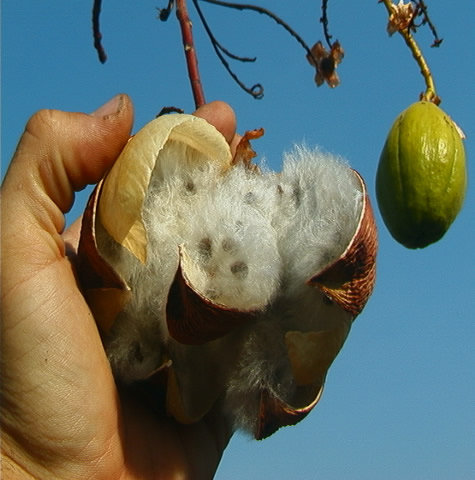THEME: Limestone Gorge
SUBJECT AREA: Environment
TOPIC: Flora of the Tropical Karst Landscape
2001 October 8, Monday. Timber Creek.
The beautiful Kapok Bush Cochlospermum fraseri is one of the rare deciduous plants of Australia. Deciduous is the antonym of Evergreen, and means that the tree loses its leaves each year. Most Australian trees are Evergreen. Its lack of leaves makes the Kapok an easy place for birds to land, and entices them with unobstructed views of the surrounding gorge. They will not, however, rest for long, as the rugged skeletal form offers no shelter from the fierce rays of the sun.

The Kapok is native to the Top End, and thrives amazingly well in the heat and humidity. Throughout the dry season, the dormant Kapok appears as a dry twig. As we have visited later than the usual tourist season, we have been lucky enough to see the bursts of large, bright yellow flowers which greet the first of the summer rains. Despite fragile appearances, these fantastic flowers are hardy enough to last on the tree for several weeks.
Beside its beauty, the Kapok is both ingenious and useful. The name Kapok derives from a closely related tree found in Africa, Asia, and Latin America. Mattresses, pillows, and soft toys have been made from the cotton wool– like fibre, which is harvested from the ripe seed-pods. This soft, light fibre surrounds each seed and is released with them as the pods open. This resourceful system allows both the wind and river currents to carry the gene pool over wide distances. Many animals eat Kapok seeds, and shelter amongst the lush wet season foliage.
Some of the other special plants we’ve seen in the Limestone Gorge area include the Plains Bloodwood Eucalyptus, which supports the handsome flights of parrots inhabiting the park, and whose wood is valued for its resistance to termite damage. The Bauhinia, has dainty rounded leaves which resemble butterflies as they turn yellow in patches; Nutwood trees are conspicuous as their bark contrasts like a checkerboard, and species of gnarled Hakea and gummy Spinifex keep company with the ubiquitous Boab.
Suggested learning activities:
Identify plants which have adapted to use the wind to spread their seed-stock. Many grasses have long, light wings to do this. Bright yellow Dandelion flowers develop a white pom pom which can be released with a puff of breath. What advantages do these plants have over others you can find?
Collect seeding plants, native and otherwise, from your local area, and see how many you can identify. If possible, find someone who knows about these shrubs and grasses (like a farmer) and ask him some questions. You;ll be surprised at what you can learn about the resourcefulness of seed spreading plants.
bel